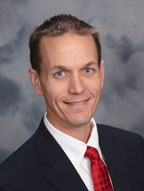This interview was originally posted on Midwest Energy News.
For two years, the Minnesota Department of Commerce has been showcasing a new approach to financing state and municipal sustainability projects around the state.
Called the Guaranteed Energy Savings Program (GESP), the concept offers organizations a way to reduce energy costs and use the savings to help pay for projects. The state created documents to help agencies and municipalities manage the program, which involves an “Energy Services Company” that develops, installs, and provides financial assistance for the projects.
It’s not an easy concept to explain even to large agencies, much less city officials. Helping to attract municipalities to the program is now the job of Peter Lindstrom, 43, former assistant director of Science Technology and Public Policy at the University of Minnesota’s Humphrey School of Public Affairs.
Lindstrom in November joined the Clean Energy Resources Teams (CERTs) as the GESP outreach coordinator to counties, cities and schools. He is also the mayor of Falcon Heights (pop. 5,300), where since taking office in 2007 he made the small community just outside St. Paul into one of the most sustainable in the state.
Lindstrom likes that CERTs is tasked with being at the front lines of getting government officials interested in the program. “I was attracted to the Clean Resource Energy Teams because I like its boots-on-the-ground approach,” Lindstrom said.
“I like how its mission is about getting real things done and having a real impact, whether it’s around community solar or Green Step Cities. It focuses on initiatives that make an impact…and this combines my passion with a day job. It’s a great thing.”
He spoke about his new role with Midwest Energy News.
 Midwest Energy News: GESP is hard to get a handle on. Can you explain it?
Midwest Energy News: GESP is hard to get a handle on. Can you explain it?
Peter Lindstrom: GESP provides the technical, financial and administrative assistance to local governments interested in using performance contracting for major infrastructure improvements.
Midwest Energy News: What is performance contracting?
Peter Lindstrom: Let’s make it easy. Say a city is spending $1,000 on energy costs and they know a new HVAC system’s energy costs will be $750. Using performance contracting allows them to use that $250 to pay off the costs of the new HVAC system and lock in lower energy costs. It’s budget neutral. It’s a way to finance energy efficiency through bundling projects — it’s HVAC, lighting, which pays for itself quickly.
Midwest Energy News: Who finances the projects?
Peter Lindstrom: It is important to keep in mind that the projects are self-financing, with the savings from the improvements paying for the project. The energy services company facilitates lease purchase financing through a third-party lender. Interest rates of lease purchase agreements vary but are generally between three and six percent and are competitively bid.
Midwest Energy News: What’s the advantage?
Peter Lindstrom: You get technical expertise from the state. The state helps you know what to look for in new systems and in the performance contract agreement. The projects are financed through leases, which Commerce has developed for the GESP program. The state has pre-qualified 11 energy companies for projects and those companies have signed on to a master agreement with Commerce to provide GESP services. A local government can be assured these companies have been thoroughly vetted.
Midwest Energy News: Anything else?
Peter Lindstrom: These are guaranteed energy savings and to do that you need measurement and verification of the savings the company said would materialize. The contracts guarantee installation costs, equipment performance and energy and financial savings. If savings don’t happen the company is on the hook to cut the local government a check to make up the difference.
Midwest Energy News: So basically the municipality pays for the equipment through energy savings?
Peter Lindstrom: Yes. Another advantage is that cities aren’t spending as much on maintenance, either, Not only are local government’s saving energy but there are measurable operation and maintenance cost savings as well.
Midwest Energy News: Are any GESP projects in motion?
Peter Lindstrom: A number of state entities are moving forward through GESP, such as the Department of Natural Resources, the National Guard and some MnSCU institutions.
Midwest Energy News: What about municipalities?
Peter Lindstrom: From the municipal adoption standpoint it has been slower, with Bemidji and Tracy moving forward. A number of local governments are checking GESP out.
Midwest Energy News: What does the Bemidji project look like?
I know Bemidji is making improvements to their HVAC systems, building envelopes — windows, that sort of thing. They are doing lighting as well.
Midwest Energy News: Is that a typical project?
Peter Lindstrom: Those thing are pretty typical of these projects — upgrading to high efficiency boilers, to better HVAC system design and equipment, and lighting. We’re also water conservation projects and doing things like geothermal and other renewables.The really important thing is to bundle different improvements together.
Midwest Energy News: What are the challenges of selling the program to communities and counties?
Peter Lindstrom: One issue is always the amount of time these projects take. It can a long time to secure the financing and get the contracts signed. It’s a complex process, but the benefits can make this time investment well worth it — and that’s the case I’m working to make.
Click here to learn more about GESP >>
About the Local Government Energy Action Series:
This effort tells the stories of Minnesota municipalities, counties, and schools and the tangible results of their energy-saving efforts to inspire others to take their own actions.


